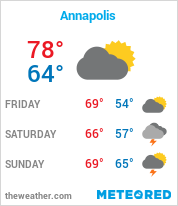 Annapolis Angler's
Club
Annapolis Angler's
Club 
Current Newsletter
Meeting Info
Monthly Calendar
Fishing Tips
Pictures
Files and Links
Club Contact List
Evan Foundation
Saltwater Fishing Expo

National Data Buoy Center, Thomas Point
| Trolling
Trolling tips for trophy Rockfish in the Chesapeake Bay .... Tryand stay away from the pack. If you're off by yourself, there's less to spook the fish, and you're the only one there with baits in the water.Troll in an East/West direction, zig zagging your way to the North or South. Your speed should be in the 2.8 to 3.8 knots range, but ifyou're missing fish, speed up a bit. |
Planer
Boards are your friends! When fishing planer boards use the commercial carabineer releaseor shower curtain hooks with a #33 Staples brand rubber band. Remember, your longest line out is the one you set closest to the board andfarthest forward in the rod holders. Generally, don't set any lines beyond 100' back of the boards. A good starting point in finding fishis to run a 6 oz. bait, 60' back of the planer board. And please, watch your boards and boat control. We all have the same right of way whiletrolling boards, it's a give and take jungle out there! |
Odds
and Ends Use Johnson's "No More Tangles" on your parachutes, they'll lookbetter in the water! Soak your reels in fresh water for 3 or 4 hours to get all the salt washed out of them. Freeze milk jugs full of water forkeeping your fish cooler cold. You can add scent to your plastics by soaking them in scent liquids inside a plastic bag and zapping them for10 to 20 seconds in the microwave. |
| Tidal
Fish Forums RSS Feed from TidalFish.com |
Circle
Hooks
Some interesting facts are that this design was primarily used in long-line fishing, and before that, by our ancestors.They were used for a good reason. Simply stated, the fish hook themselves and 95% of the time, in the lip. This meant that they wereusually still alive when the lines were checked. Circle hook effectiveness is based on Math and Physics, specifically,Newton's second law of motion and centripetal (center-seeking force). It is important to note, that using these hooks is not a complete "nobrainer." It's been my experience using these on Assateague for the last few years, that there are some tips one should follow:
|
Boat fishing for striped
bass There are many ways to fish for striped bass froma boat. These include, but are not limited to, the following: 1.Dunking bunker chunks while anchored. We caught a 39 pound striped bass from a 21 foot boat while anchored in Delaware Bay. The bait was abunker head. Chumming was used. 2. You can also fish with clamswhile anchored. Boat fisherman who fish their local waters often, especially charter captains, get to know where all the clam beds are intheir area. In the days after a storm, these fishermen anchor over these clam beds, and fish using clams for bait. They know that thestorms stir up the clam beds, and that stripers will be there feeding on broken clams. 3. Live lining bunker. This often involves snaggingbunker, then fishing them live. Most boat fishermen snag the bunker using a treble hook, place them in a live well, then fish them onanother rod rigged with a circle hook. 4. Drifting over structure orlumps on the bottom. Live eels are often the bait of choice. Greg Myerson caught his world record striped bass drifting a live eel near asubmerged boulder. 5. Jigging with diamond jigs or other lures. This is a good choice whensand eels are the prevalent bait. 6. Trolling deep diving plugs, like Mann's Stretch 25s. 7.Trolling bunker spoons, surgical tubes with worms, umbrella rigs, or parachute rigs. This often requires the use of wire or lead core lineto get the lures deep. Planer boards are often used to keep lines from crossing and away from the boat. 8. Casting plugs or other lures close to bars, shore points, or jettys. 9. Drifting live bait like spot. Some fishermen drift the live eelsunder bobbers. 10. Live lining herring in rivers in the spring. 11.Casting plugs or other lures to the edge of sod banks within the many estuaries along the east coast. This works best in the early hoursbefore sunrise. 12. Fishing near bridge pilings, for example at the Chesapeake BayBridge. 13. Chasing birds, and fishing blitzes during both the spring and fallmigrations. Snag a bunker or throw a pencil popper. |